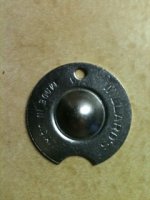This is an old school tip for roughing up a smooth cue tip. It involves the use of a wood file/rasp (I use a Nicholson Half-Round 4-in-Hand Rasp and File, Rasp Cut, American Pattern, 8" Length, available on Amazon).
To use the file, first assemble your cue. Hold the cue upright with the but against the floor and, using the flat file (not the rasp!!) portion of the tool, just press the tip against and hold the cue an angle appropriate to the area (bottom, middle or top) to be roughened and roll the shaft of the cue towards you. As you complete the rolling motion, the tip will be impressed against the teeth of the file. After a few light passes, the file should be re-positioned so the rest of the tip is addressed.
When used properly, the file will not change the shape of the tip.
Using a file in this manner is quick and produces uniform results.
It may just be my perception, but I find that my tips last longer when using a file compared to a Pik.
I store my file/rasp in a homemade paper sleeve that I keep in my cue case.
To use the file, first assemble your cue. Hold the cue upright with the but against the floor and, using the flat file (not the rasp!!) portion of the tool, just press the tip against and hold the cue an angle appropriate to the area (bottom, middle or top) to be roughened and roll the shaft of the cue towards you. As you complete the rolling motion, the tip will be impressed against the teeth of the file. After a few light passes, the file should be re-positioned so the rest of the tip is addressed.
When used properly, the file will not change the shape of the tip.
Using a file in this manner is quick and produces uniform results.
It may just be my perception, but I find that my tips last longer when using a file compared to a Pik.
I store my file/rasp in a homemade paper sleeve that I keep in my cue case.

